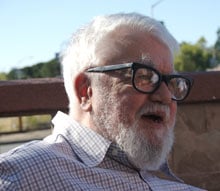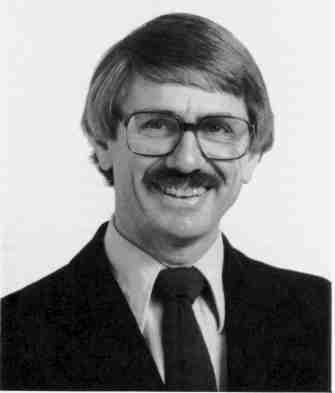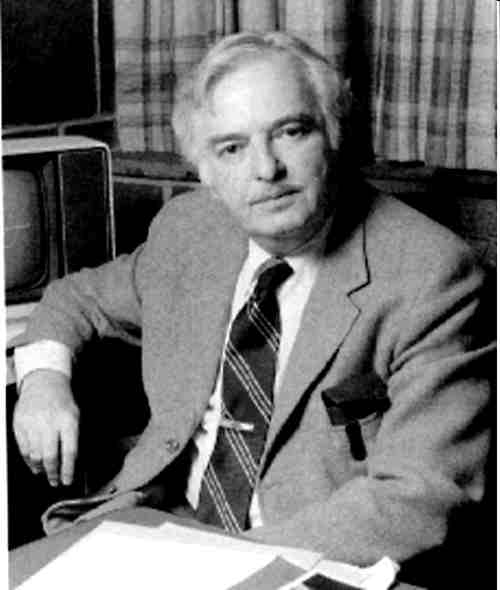(A guest post from Mr. Ray Holloman, NJVC Digital Communications Manager )
For more than half a century, cloud computing has changed
names more often than a Hollywood starlet.
Utility computing. Time share. Thin client. SaaS. PaaS. IaaS.
While concepts have been added and capabilities grown, cloud computing was no
more invented by Amazon or other modern vendors in the last seven years reality
invented by reality shows. It’s simply been advance, repackaged and repurposed
for as long as computer connectivity has existed.
In honor of Father’s Day, NJVC looks up the family tree of
cloud computing to say thank you to six of the fathers of cloud computing. (And if you’re wondering about a gift, a single tie will
suffice. Certainly, these guys understand how to share.)
 Dr. John
McCarthy—In the manner that genius tends to be promiscuous in emerging
fields, McCarthy is often given credit as the father or influencer of many
things, including Artificial Intelligence, e-commerce and time-share computing—what
may be considered the earliest implementation of cloud computing. In 1961,
McCarthy famously described the future of networked computing as a utility.
“Computing may someday be organized as a public utility, just as the telephone
system is a public utility. Each subscriber needs to pay only for the capacity
he actually uses, but he has access to all programming languages characteristic
of a very large system. … Certain subscribers might offer service to other
subscribers. … The computer utility could become the basis of a new and
important industry.” McCarthy’s vision of the computing network to come was
mainframe—based in a way that somewhat missed the bull’s eye, but hit the right
target, regardless of the technology’s name. “We keep inventing new names for
timesharing,” McCarthy’s Stanford colleague Les Earnest told the Los Angeles Times when McCarthy died in
2011. (http://www.stanford.edu/~learnest/).
“It came to be called servers. … Now we call it cloud computing. That is still
just time-sharing. John started it." For those born in the Internet era,
McCarthy’s familiar wobbly bonnet of gray hear and thick, black horn-rimmed
glasses marked him as someone of another time, and he was—though he may have
been a man of the future rather than the past. McCarthy’s concept of the rise
of cloud computing wasn’t perfect—he shortchanged the value of the personal
computer—but his implementation of timesharing set a course for cloud computing,
which is only just being realized.
Dr. John
McCarthy—In the manner that genius tends to be promiscuous in emerging
fields, McCarthy is often given credit as the father or influencer of many
things, including Artificial Intelligence, e-commerce and time-share computing—what
may be considered the earliest implementation of cloud computing. In 1961,
McCarthy famously described the future of networked computing as a utility.
“Computing may someday be organized as a public utility, just as the telephone
system is a public utility. Each subscriber needs to pay only for the capacity
he actually uses, but he has access to all programming languages characteristic
of a very large system. … Certain subscribers might offer service to other
subscribers. … The computer utility could become the basis of a new and
important industry.” McCarthy’s vision of the computing network to come was
mainframe—based in a way that somewhat missed the bull’s eye, but hit the right
target, regardless of the technology’s name. “We keep inventing new names for
timesharing,” McCarthy’s Stanford colleague Les Earnest told the Los Angeles Times when McCarthy died in
2011. (http://www.stanford.edu/~learnest/).
“It came to be called servers. … Now we call it cloud computing. That is still
just time-sharing. John started it." For those born in the Internet era,
McCarthy’s familiar wobbly bonnet of gray hear and thick, black horn-rimmed
glasses marked him as someone of another time, and he was—though he may have
been a man of the future rather than the past. McCarthy’s concept of the rise
of cloud computing wasn’t perfect—he shortchanged the value of the personal
computer—but his implementation of timesharing set a course for cloud computing,
which is only just being realized.  J.C.R. Licklider—In the late 1950s and early
1960s, even technical lexicon came adorned with the influence of Buck Rogers
and the space race. Thus Licklider’s 1962 declaration of a vision that would
become the Internet bore the unmistakably audacious and space age sobriquet
“Intergalactic Computer Network.” If Licklider spoke on a vast scale, he
thought on even broader one, constrained by the bandwidth of the times, not the
bandwidth of mind. His Intergalactic Computer Network concept spurred the
creation of the Advanced Research Projects Agency Network, a direct ancestor of
the modern Internet and the globally connected world. But “Lick,” as he was commonly
known, understood the possibilities of cloud computing in a manner more
liberating than more utilitarian vision of McCarthy’s early predictions.
Licklider saw the possibility of global computing as an element of the human
lifescape—a tool of personal connectivity, not merely an agent of business.
J.C.R. Licklider—In the late 1950s and early
1960s, even technical lexicon came adorned with the influence of Buck Rogers
and the space race. Thus Licklider’s 1962 declaration of a vision that would
become the Internet bore the unmistakably audacious and space age sobriquet
“Intergalactic Computer Network.” If Licklider spoke on a vast scale, he
thought on even broader one, constrained by the bandwidth of the times, not the
bandwidth of mind. His Intergalactic Computer Network concept spurred the
creation of the Advanced Research Projects Agency Network, a direct ancestor of
the modern Internet and the globally connected world. But “Lick,” as he was commonly
known, understood the possibilities of cloud computing in a manner more
liberating than more utilitarian vision of McCarthy’s early predictions.
Licklider saw the possibility of global computing as an element of the human
lifescape—a tool of personal connectivity, not merely an agent of business.
“10: IF {Cloud Pioneer} Then GOTO 20
20: PRINT “THANK YOU.”
 Dartmouth
Professors Kemeny and Kurtz designed the BASIC programming language to allow
students to write programs on the Dartmouth Time Sharing System (DTSS), the
first successful, large-scale implementation of time-sharing, in 1964. While
the technology was then still called timesharing, the underlying concepts,
remote access and shared resources, have the same genetic markers of what is
now cloud computing. Kemeny and Kurtz’s introduction of BASIC also underscored
another key concept of modern cloud computing—ease of use. By the 1970s, the
DTSS supported more than 300 users—and 300 pairs of bellbottoms—simultaneously.
The system lasted 35 years, before being deprecated in 1999, and proved the
feasibility of the earliest cloud.
Dartmouth
Professors Kemeny and Kurtz designed the BASIC programming language to allow
students to write programs on the Dartmouth Time Sharing System (DTSS), the
first successful, large-scale implementation of time-sharing, in 1964. While
the technology was then still called timesharing, the underlying concepts,
remote access and shared resources, have the same genetic markers of what is
now cloud computing. Kemeny and Kurtz’s introduction of BASIC also underscored
another key concept of modern cloud computing—ease of use. By the 1970s, the
DTSS supported more than 300 users—and 300 pairs of bellbottoms—simultaneously.
The system lasted 35 years, before being deprecated in 1999, and proved the
feasibility of the earliest cloud. Vivek Kundra—In the process-driven
bureaucracy of federal IT, implementing organizational change can be a little
like steering a battleship with a pair of wooden oars. But Kundra, the nation’s
first federal CIO, managed to leave an enterprise-level legacy during his
two-and-a-half-year tenure, highlighted most pointedly by the acceptance of
cloud in the federal IT vocabulary. Kundra’s “25 Point Implementation Plan to
Reform Federal IT,” remains a core vision statement in federal IT; his
cloud-first mandate one of era-markers in government infrastructure. Perhaps
his greatest contribution, though, was simply consensus building, gaining
acceptance for cloud computing among federal leadership through something of a
charisma crusade. “The force of his personality [led] to the rapid adoption of
cloud computing as a major driver of reform,” NJVC Vice President and General
Manager, Cloud Services, Kevin L. Jackson wrote in 2011. While the returns on
Kundra’s initiatives remain uncertain, the first chapter of the book of federal
cloud will be littered with references to his work.
Vivek Kundra—In the process-driven
bureaucracy of federal IT, implementing organizational change can be a little
like steering a battleship with a pair of wooden oars. But Kundra, the nation’s
first federal CIO, managed to leave an enterprise-level legacy during his
two-and-a-half-year tenure, highlighted most pointedly by the acceptance of
cloud in the federal IT vocabulary. Kundra’s “25 Point Implementation Plan to
Reform Federal IT,” remains a core vision statement in federal IT; his
cloud-first mandate one of era-markers in government infrastructure. Perhaps
his greatest contribution, though, was simply consensus building, gaining
acceptance for cloud computing among federal leadership through something of a
charisma crusade. “The force of his personality [led] to the rapid adoption of
cloud computing as a major driver of reform,” NJVC Vice President and General
Manager, Cloud Services, Kevin L. Jackson wrote in 2011. While the returns on
Kundra’s initiatives remain uncertain, the first chapter of the book of federal
cloud will be littered with references to his work. 
( Thank you. If you enjoyed this article, get free updates by email or RSS - © Copyright Kevin L. Jackson 2012)
--> --> -->
